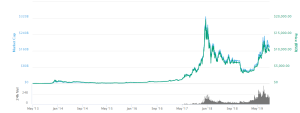Bitcoin Gold Mining: A Comprehensive Guide
Dive deep into the Bitcoin Gold mining world! Uncover the technicalities, potential profits, and significant challenges. Is it worth the effort? Find out now!
The world of cryptocurrency is constantly evolving, presenting both opportunities and challenges. Bitcoin Gold (BTG), a fork of Bitcoin, emerged with the promise of a more decentralized and accessible mining experience. This guide delves deep into the intricacies of Bitcoin Gold mining, examining the technical aspects, the potential rewards, and the significant hurdles involved. Understanding these facets is crucial for anyone considering venturing into this competitive landscape. We will explore everything from hardware requirements to the evolving regulatory environment.
Understanding Bitcoin Gold (BTG)
Bitcoin Gold was created in 2017 with the primary goal of making Bitcoin mining more accessible to individuals using standard computer hardware, rather than the specialized ASICs (Application-Specific Integrated Circuits) that dominated Bitcoin mining at the time. This aimed to counter the increasing centralization of Bitcoin mining power. BTG employed a different mining algorithm, Equihash, which was designed to be more resistant to ASIC dominance, theoretically leveling the playing field for miners with less powerful equipment.
However, the reality proved to be more complex. While ASICs were initially less effective against Equihash, dedicated ASIC miners for BTG eventually emerged, once again concentrating mining power in the hands of a few large operations. This evolution highlights the inherent challenge in creating a truly decentralized cryptocurrency mining ecosystem.
Equihash Algorithm Explained
The Equihash algorithm is a proof-of-work algorithm designed to be ASIC-resistant. Unlike SHA-256 used by Bitcoin, Equihash requires solving complex mathematical problems that are more computationally intensive for ASICs than for GPUs (Graphics Processing Units) and FPGAs (Field-Programmable Gate Arrays). This makes it theoretically more accessible to individual miners with less specialized equipment.
The algorithm’s complexity lies in its reliance on finding a solution within a specific subset of solutions, which requires a significant amount of computational power, regardless of the hardware used. The process involves finding a certain number of “equivalence classes” within a larger set of potential solutions, making it computationally expensive, but also relatively more resistant to ASIC optimization in its early stages.
The Hardware Landscape for Bitcoin Gold Mining
While Bitcoin Gold was intended to be more accessible, effective mining still requires significant hardware investment. GPUs remain a viable option, particularly high-end graphics cards with substantial memory and processing power. However, even with powerful GPUs, profitability can be significantly influenced by factors such as electricity costs and the current difficulty of the BTG network.
The initial promise of GPU-based mining has been somewhat diminished by the emergence of ASIC miners specifically designed for Equihash. Although less prevalent than in Bitcoin mining, these specialized machines offer significantly higher hash rates, making them more efficient and profitable for large-scale mining operations.
Choosing the Right Hardware
- Graphics Cards (GPUs): High-end NVIDIA and AMD cards with ample VRAM are preferred. Consider factors like power consumption and cooling solutions. A careful cost-benefit analysis is crucial.
- ASIC Miners (if budget allows): These are the most efficient but also the most expensive option. Research thoroughly before investing, as the ROI (Return on Investment) can vary greatly.
- Motherboard and CPU: A motherboard capable of supporting multiple GPUs and a CPU with sufficient processing power are essential.
- Power Supply: A reliable and high-capacity power supply is crucial to handle the power demands of multiple GPUs or an ASIC miner.
- Cooling System: Effective cooling is paramount to prevent overheating and maintain optimal performance. Consider using specialized cooling solutions for high-performance hardware.
Software and Mining Pools
Mining Bitcoin Gold requires specialized software to manage the mining process. Popular choices include mining pools like 2Miners, which provide a collaborative environment for miners to share their computing power and increase their chances of successfully mining BTG. These pools pool resources and distribute rewards proportionally to each miner’s contribution.
Choosing the right mining pool is essential. Factors to consider include the pool’s size, fee structure, payment methods, and overall reliability. Research various pools to find one that aligns with your mining strategy and tolerance for risk. Larger pools often offer greater stability and more frequent payouts.
Setting up Your Mining Rig
Setting up a Bitcoin Gold mining rig involves several steps, including installing the appropriate operating system, configuring the mining software, joining a mining pool, and carefully monitoring the hardware’s performance and temperature. Detailed tutorials and guides are readily available online, but careful attention to detail is crucial to avoid potential issues.
It’s also important to understand the power consumption of your setup. Electricity costs can significantly impact the profitability of mining, especially if your hardware is inefficient or if electricity prices are high. Careful monitoring and optimization of power consumption are key to maximizing profits.
The Economics of Bitcoin Gold Mining
The profitability of Bitcoin Gold mining is highly dynamic and depends on several interconnected factors. The most important are the current price of BTG, the network’s difficulty, the cost of electricity, and the efficiency of your mining hardware. Fluctuations in any of these factors can significantly impact your profitability, sometimes leading to periods where mining becomes unprofitable.
Network difficulty adjusts automatically based on the total hash rate of the network. As more miners join the network, the difficulty increases, making it harder to mine BTG. This is a self-regulating mechanism to maintain a consistent block generation rate.
Calculating Profitability
Calculating the profitability of Bitcoin Gold mining requires careful consideration of all these factors. Online calculators and spreadsheets are available to help estimate profitability, but it’s important to input accurate data and understand the inherent uncertainties involved. These calculations provide only an estimate, as the market conditions and the network difficulty can change rapidly.
Remember that mining involves inherent risks, and there’s no guarantee of profit. Carefully weigh the potential rewards against the costs and risks before investing significant resources in Bitcoin Gold mining.
Regulatory Considerations and Risks
The regulatory landscape surrounding cryptocurrency mining is constantly evolving, and it varies significantly across different jurisdictions. Some countries have embraced cryptocurrency and have relatively lenient regulations, while others have imposed stricter regulations or outright bans. It’s crucial to understand the legal framework in your location before engaging in Bitcoin Gold mining.
Beyond legal considerations, there are inherent risks associated with cryptocurrency mining. These include the volatility of cryptocurrency prices, the potential for hardware failures, and the risk of scams and malware. It’s essential to research thoroughly and take appropriate security measures to mitigate these risks.
Legal Compliance and Security
- Tax implications: Understand the tax implications of cryptocurrency mining in your jurisdiction.
- Energy consumption: Be mindful of your energy consumption and its environmental impact.
- Security protocols: Implement strong security measures to protect your hardware and cryptocurrency holdings.
- Software updates: Keep your mining software updated to patch security vulnerabilities.
- Data privacy: Protect your personal data and be wary of phishing attempts.
Bitcoin Gold mining presents a complex and evolving landscape. While the initial vision of a more accessible mining experience has been partially realized, it’s crucial to approach this endeavor with a thorough understanding of the technical, economic, and regulatory aspects. Careful planning, research, and risk management are essential for anyone considering participating in this dynamic sector of the cryptocurrency world.
The potential rewards can be significant, but the challenges are substantial. Always remember that cryptocurrency investments, including mining activities, are inherently risky. Thorough due diligence and a realistic assessment of your resources and capabilities are crucial before embarking on this journey. Success in Bitcoin Gold mining requires constant adaptation, vigilance, and a deep understanding of the ever-changing dynamics of the cryptocurrency market. The journey is demanding, but for those prepared to navigate its complexities, the potential rewards can be substantial.
Continuous learning and adaptation are vital for success in this field. Staying informed about the latest developments in the Bitcoin Gold ecosystem, including technological advancements, regulatory changes, and market trends, will greatly enhance your chances of success. Remember, successful mining requires a strategic approach, patience, and a willingness to learn and adapt to the ever-changing landscape.
Ultimately, Bitcoin Gold mining presents a unique opportunity, but it’s not a guaranteed path to riches. The rewards are there for those who are well-informed, well-prepared, and willing to accept the inherent risks. The journey requires dedication, resilience, and a keen understanding of the evolving world of cryptocurrency.
With careful planning and a realistic approach, Bitcoin Gold mining can become a profitable endeavor, but it’s not without its challenges.






